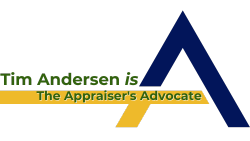Is USPAP misleading? By now you have likely heard the news. And, by the way, HOORAY for our side! We got it changed!
Until January 1, 2020 USPAP never contained a definition of the terms to mislead or misleading. In any event, for the 2020-2021 USPAP cycle, there is a definition of misleading. Yet, the big news is that, for the 2022-2023 USPAP cycle, The Appraisal Foundation and the ASB proposed to remove that definition from USPAP. Given USPAP’s current definition of misleading, that is likely a step forward. Misleading the client(s) and/or the intended user(s) will be still be a major ethics violation. But a simple typo, for example, would not.
To see need for a change, look at the definition: “Intentionally or unintentionally misrepresenting, misstating, or concealing relevant facts or conclusions” (emphasis added). In podcasts and other blogs, others and I have pointed out some of the (unintended?) problems with this definition:
- Because of the inclusion of the word unintentionally, something in a report as simple and innocent as a typo or transposed numerals could qualify as “misleading”. This calls into question the credibility of the underlying appraisal, the integrity of the entire report, as well as the reputation of the authoring appraiser. A typo or a transcribed numeral should not accomplish this;
- It is typical for appraisers to omit an analytical discussion of the subject’s zoning, other than to state the major, general zoning classification. Say an appraiser were to indicate in the report the subject’s zoning was R-1. Nevertheless, if the appraiser omits an analytical discussion of the ramifications and implications of that zoning classification, has the appraiser misrepresented, misstated, or concealed a relevant fact? After all, zoning is a component of highest and best, thus of market value, too.
- Per USPAP SR1-3(a), there are five (5) components to market analysis and highest and best use. Suppose the appraiser were to fail to identify and analyze the effect on use and value of the reasonably probable modifications of any land use regulations on the subject. Is this all-too-frequent omission misleading?
To be sure, there are more such questions. But these examples are sufficient to illustrate the potential problems there are with this current definition, as well as the need to clarify it. Or, as is the case to be in the next USPAP, to eliminate it.
Numerous appraisers and appraisal groups raised this issue with The Appraisal Foundation and the ASC. Some did so openly, publicly, and sensationally. But the point is, that opposition, worked. In the second draft of the proposed 2022-2023 USPAP, TAF/ASC shows the definition of misleading with a strikethru (strikethru) of the typeface. So, the proposal is to remove it, not merely change it. Further, in that proposal draft, there was no replacement for that definition, either.
But there was another matter to consider, too. From the opposition, it was also clear that to mislead, was not merely to make a sanctionable mistake. It was to make any mistake one worthy of state sanction. Via that definition, any mistake could ascend to the level of an ethics violation, depending on the whim of the enforcing state appraisal board. In and of itself, to violate ethics is a serious infraction of the rules. Its seriousness comes from the fact it stems from a choice freely made, not ignorance or inadvertence. It is that choice that makes a knowledge of ethics so important.
USPAP’s definition basically made an intentional act of misleading, etc. into an ethics violation. That is as it should be (and, frankly, already was). However, USPAP’s current definition also makes unintentional acts into misleading acts. Thus, an innocent act of omission was just as unethical as was an unethical act purposefully made.
So, is USPAP misleading? It was not in defining misleading. It was in failing to differentiate between an act of inadvertence and an act of deliberation. Yet it declared both to be unethical. So, we appraisers (as well as others) brought these inconsistencies to the attention of the good folks at TAF and the ASB. Via this industry-wide participation, TAF/ASC chose to rescind the definition.
What we learn from this is that working together on a challenge brings results. That’s something we appraisers, who are generally way too eager to throw each other under the bus (hear that review appraisers!?), need to remember in the future.
If I can ever be of help to you in any area of real estate appraisal, please contact me, Tim Andersen, at tim@theappraisersadvocate.com. It will be an honor to work with you!

